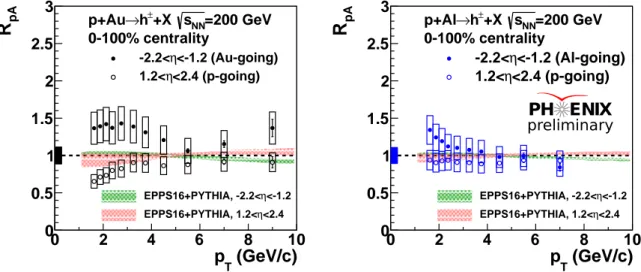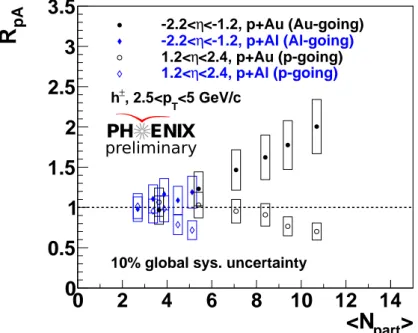Nuclear Physics A 00 (2018) 1–4
Nuclear
Physics A
www.elsevier.com/locate/procedia
XXVIIth International Conference on Ultrarelativistic Nucleus-Nucleus Collisions
(Quark Matter 2018)
PHENIX study of the initial state with forward hadron
measurements in 200 GeV p(d)
+A and
3
He
+Au collisions
Jason Bryslawskyj for the PHENIX collaboration
University of California, Riverside, CA 92507
Abstract
Forward hadron measurements in p(d)+A provide a signal to study nuclear shadowing, initial state energy loss and/or gluon saturation effects as a function of rapidity, centrality and energy. High pT identified π0 measurements are an
essential first step toward measuring prompt photon production. The π0 measurements are enabled by the PHENIX
MPC-EX detector, a Si-W preshower detector located in front of the Muon Piston Calorimeter (MPC), expanding the neutral pion reconstruction capabilities in the rapidity range 3.1 < η < 3.8 out to high energies, E < 80 GeV. Previous PHENIX measurements of punch-through charged hadrons in the muon arms in the rapidity range 1.4 < |η| < 2.2 were significantly improved through the capability of the forward silicon vertex detector (FVTX) to determine the transverse momentum and rapidity with high precision and reject background from secondary hadrons.
PHENIX collected d+Au data with the MPC-EX in the 2016 run at √sNN= 200, 62, 39 and 19.6 GeV; and p+p and
p+Au(Al) data with the FVTX in 2015 at 200 GeV. In this talk, we will present first results for high pTπ0 production
from the √sNN= 200 GeV dataset, the status of the prompt photon measurement, as well as charged hadron nuclear
modification factors in p+Au(Al) and3He+Au.
Keywords: small systems, initial state, forward physics, backward physics, hadrons, PHENIX
1. Introduction
Asymmetric collision systems provide unique insight in to the nature of strongly interacting matter. New PHENIX measurements are presented for forward and backward charged hadron suppression in 200 GeV p+Au and p+Al. Small-x regions of the heavy nucleus can be probed at forward rapidity, whereas large-x regions can be examined at backwards rapidity. The forward silicon vertex detector (FVTX) was leveraged to improve the reconstruction of punch-through charged hadrons in the PHENIX muon arm spectrometers. The FVTX consists of 4 layers of silicon tracking planes placed close to the collision vertex. Background particles which do not originate from the collision vertex, such as secondary hadrons are rejected by requir-ing hits in the FVTX. By obtainrequir-ing precision position measurements near the collision vertex, the FVTX also allows measurement of particle (pseudo)rapidity to high precision. Muon contribution in the measured
2 / Nuclear Physics A 00 (2018) 1–4
transverse momentum range (pT > 1.5) is estimated to be less than 5%, based on Geant 4 simulation of
hadron cocktails with realistic pT and pseudorapidity (η) distributions.
(GeV/c)
Tp
0 2 4 6 8 10 pAR
0 0.5 1 1.5 2 2.5 3 =200 GeV NN s +X ± h → p+Au 0-100% centrality <-1.2 (Au-going) η -2.2< <2.4 (p-going) η 1.2< <-1.2 η EPPS16+PYTHIA, -2.2< <2.4 η EPPS16+PYTHIA, 1.2<(GeV/c)
Tp
0 2 4 6 8 10 pAR
0 0.5 1 1.5 2 2.5 3 =200 GeV NN s +X ± h → p+Al 0-100% centrality <-1.2 (Al-going) η -2.2< <2.4 (p-going) η 1.2< <-1.2 η EPPS16+PYTHIA, -2.2< <2.4 η EPPS16+PYTHIA, 1.2<PH ENIX
preliminaryFig. 1. Nuclear modification factor (RpA) of charged hadrons as a function of transverse momentum (pT) in 200 GeV p+Au (left) and 200 GeV p+Al (right). Forward hadrons are shown as open circles and backward hadrons as closed. Data is compared to an RpA calculated from EPPS16[1]. We define forward (pseudo)rapidity as the p-going direction and backwards in the A-going direction.
2. Results and Discussion
Single particle modification is quantified with the nuclear modification factor RpA:
RpA=
(1/NevtpA)d2NpA/dpTdy
hTpAi × d2σpp/dpTdy
, (1)
where σppis the p+p cross section for the single hadron process and hTpAi is the nuclear thickness function.
The nuclear modification factor (RpA) of charged hadrons as a function of transverse momentum (pT) is
shown on the left hand plot of Figure 1 for 200 GeV p+Au compared to 200 GeV p+Al on the right hand side. Forward hadrons in the pseudorapidity range 1.2 < η < 2.4 are plotted as filled circles and backward hadrons (−2.2 < η < −1.2) as open circles. Both are compared to nuclear modification factors calculated using the nuclear parton distribution function (nPDF) EPPS16[1]. The comparison RpAis calculated from
the EPPS16 nPDF using PYTHIA, specifically the Pythia8 MB (SoftQCD:inelastic) tune using the CT10 pp-pdf.
As can be seen in Figure 1, forward charged hadrons are suppressed, especially at low pT. They are
suppressed to a greater degree in the larger system p+Au than in p+Al. The suppression of forward hadrons is consistent with an RpAcalculated using EPPS16 [1]. Backward hadrons, on the other hand, are enhanced
in p+Au and to a lesser extent in p+Al. These results are consistent with previous PHENIX measurements of forward and backward heavy flavor leptons as well as φ mesons in 200 GeV d+Au[2].
The enhancement of backward hadrons is greater in magnitude than the calculated RpAfrom EPPS16.
One can see this especially well in Figure 2, where RpAis plotted as a function of pseudorapidity η. This
indicates the existence of effects beyond those explained by the nuclear parton distribution function alone. This enhancement has several possible explanations. It may be due to transverse momentum broadening from incoherent multiple scattering of partons in the larger nucleus[3],[4]. Another possibility, is a backward enhancement caused by radial flow, as discussed for heavy-flavor quarks in [5] and consistent with the blast-wave model fit by the STAR experiment to light-flavor spectra[6].
/ Nuclear Physics A 00 (2018) 1–4 3
η
-3 -2 -1 0 1 2 3 pAR
0 0.5 1 1.5 2 2.5 =200 GeV NN s +X ± h → p+Au 0-100% centrality <5 GeV/c T 2.5<p Au-going p-going EPPS16+PYTHIAη
-3 -2 -1 0 1 2 3 pAR
0 0.5 1 1.5 2 2.5 =200 GeV NN s +X ± h → p+Al 0-100% centrality <5 GeV/c T 2.5<p Al-going p-going EPPS16+PYTHIAPH ENIX
preliminaryFig. 2. Nuclear modification factor (RpA) as a function of pseudorapidity η of charged hadrons in 200 GeV p+Au (left) and 200 GeV p+Al (right). Forward hadrons are shown as open circles and backward hadrons as closed. Data is compared to RpAcalculated using EPPS16[1]. 2 4 6 8 10 CP R 0.5 1 1.5 2 2.5 3 3.5 =200 GeV NN s +X ± h → p+Au 0-5% centrality <-1.2 (Au-going) η -2.2< <2.4 (p-going) η 1.2< 2 4 6 8 10 0.5 1 1.5 2 2.5 3 3.5 =200 GeV NN s +X ± h → p+Au 5-10% centrality <-1.2 (Au-going) η -2.2< <2.4 (p-going) η 1.2< 2 4 6 8 10 0.5 1 1.5 2 2.5 3 3.5 =200 GeV NN s +X ± h → p+Au 10-20% centrality <-1.2 (Au-going) η -2.2< <2.4 (p-going) η 1.2< (GeV/c) T p 2 4 6 8 10 pA R 0 0.5 1 1.5 2 2.5 3 =200 GeV NN s +X ± h → p+Au 20-40% centrality <-1.2 (Au-going) η -2.2< <2.4 (p-going) η 1.2< (GeV/c) T p 2 4 6 8 10 0 0.5 1 1.5 2 2.5 3 =200 GeV NN s +X ± h → p+Au 40-60% centrality <-1.2 (Au-going) η -2.2< <2.4 (p-going) η 1.2< (GeV/c) T p 2 4 6 8 10 0 0.5 1 1.5 2 2.5 3 =200 GeV NN s +X ± h → p+Au 60-84% centrality <-1.2 (Au-going) η -2.2< <2.4 (p-going) η 1.2< pA R 0.5 1 1.5 2 2.5 3 3.5 pA R 0 0.5 1 1.5 2 2.5 3 PH ENIX preliminary
Fig. 3. Charged hadron nuclear modification factor (RdAu) in 200 GeV p+Au as a function of transverse momentum (pT) plotted for various centralities. Both the backward enhancement as well as the forward suppression appear to depend strongly on centrality.
Examining RpA as a function of centrality, shows a clear centrality dependence of both the backward
enhancement as well as the forward suppression of charged hadrons. Centrality is determined based on the charge distribution in beam-beam counters located within a pseudorapidity range of −3.9 < η < −3.1. RpA
vs. pT is shown for various centrality bins in Figure 3 for 200 GeV p+Au. Both effects are most apparent
4 / Nuclear Physics A 00 (2018) 1–4
(calculated from Glauber Monte Carlo) in Figure 4 for both p+Au and p+Al. The enhancement of backward hadrons scales with hNparti across the two different collision systems.
>
part<N
0
2
4
6
8
10
12
14
pAR
0
0.5
1
1.5
2
2.5
3
3.5
<5 GeV/c T , 2.5<p ± h10% global sys. uncertainty
<-1.2, p+Au (Au-going) η -2.2< <-1.2, p+Al (Al-going) η -2.2< <2.4, p+Au (p-going) η 1.2< <2.4, p+Al (p-going) η 1.2<
PH ENIX
preliminary
Fig. 4. Charged hadron nuclear modification factor (RdAu) as a function of the number of participants hNparti, plotted for both 200 GeV p+Au and p+Al. The backward enhancement of charged hadrons appears to scale with hNparti.
3. Conclusion and Future Measurements
New measurements of forward and backward charged hadrons from PHENIX in 200 GeV p+Au and p+Al are presented. Forward p-going hadrons are suppressed as expected from a variety of different effects. Backward Au-going hadrons are enhanced, perhaps due to incoherent parton multiple scattering [3],[4] or due to radial flow[5],[6]. Both effects appear larger in p+Au and in more central collisions. The backward enhancement, in fact, scales with the number of participants hNparti.
In addition to the presented measurements at high rapidity (1.2 < |η|. 2.4), PHENIX looks forward to new measurements of hadrons at even higher rapidity. Using the MPC-EX silicon preshower upgrade to the Muon Piston Calorimeter, we will be able to measure high-pT π0s and direct photons at very high rapidity
(3.1 < |η| < 3.8) and at low-x. Measuring low-x direct photons will allow direct access to the underlying gluon distribution and provide insight into gluon suppression at low-x and high centrality.
References
[1] K. J. Eskola, P. Paakkinen, H. Paukkunen, C. A. Salgado, EPPS16: Nuclear parton distributions with LHC data, Eur. Phys. J. C77 (3) (2017) 163. arXiv:1612.05741, doi:10.1140/epjc/s10052-017-4725-9.
[2] A. Adare, et al., Measurement of φ-meson production at forward rapidity in p+p collisions at√s=510 GeV and energy dependence of σφfrom√s=200 GeV to 7 TeV arXiv:1710.01656.
[3] Z.-B. Kang, I. Vitev, H. Xing, Multiple scattering effects on inclusive particle production in the large-x regime, Phys. Rev. D88 (2013) 054010. arXiv:1307.3557, doi:10.1103/PhysRevD.88.054010.
[4] Z.-B. Kang, I. Vitev, E. Wang, H. Xing, C. Zhang, Multiple scattering effects on heavy meson production in p+A collisions at backward rapidity, Phys. Lett. B740 (2015) 23–29. arXiv:1409.2494, doi:10.1016/j.physletb.2014.11.024.
[5] A. Beraudo, A. De Pace, M. Monteno, M. Nardi, F. Prino, Heavy-flavour production in high-energy d-Au and p-Pb collisions, JHEP 03 (2016) 123. arXiv:1512.05186, doi:10.1007/JHEP03(2016)123.
[6] B. I. Abelev, et al., Systematic Measurements of Identified Particle Spectra in pp, d+Au and Au+Au Collisions from STAR, Phys. Rev. C79 (2009) 034909. arXiv:0808.2041, doi:10.1103/PhysRevC.79.034909.


